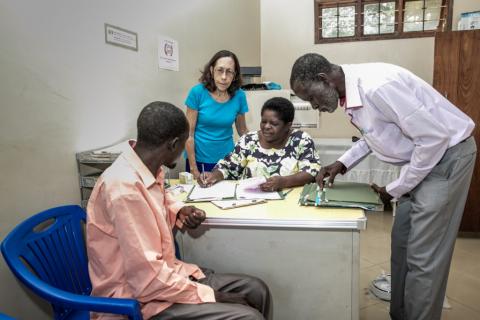
Join us in honoring World AIDS Day 2020 on December 1 by signing up for our 24 hour prayer vigil.
World AIDS Day is held on December 1 each year around the world. It is an opportunity to raise awareness of HIV/AIDS, commemorate those who have died, and celebrate victories in treatment and prevention.
Click here to sign up for a one-hour time slot during our annual World AIDS Day 24-hour prayer vigil.
The theme put forward by the UN for World AIDS Day 2020 is “Global solidarity, shared responsibility,” recognizing the need for global cooperation to help prevent HIV/AIDS and protect those infected, especially during the COVID-19 pandemic.
Since the beginning of the HIV/AIDS epidemic in 1981, Maryknoll missioners in Asia, Latin America, and Africa have been working in ministries serving individuals living with HIV and AIDS. In that time period, the world has made great strides in addressing the epidemic, though there is still lots of work to be done.
Maryknoll Lay Missioner Joanne Miya, for example, directs Uzima Center in Tanzania, which provides services for about 300 people living with HIV/AIDS. She says, "When I first joined this program, we had 30 adult clients who were HIV positive. Pretty much, it was a hospice program. We spent a lot of time going to funerals. The antiretroviral drugs were not yet available. Every month we’d register a few people, then a few people would pass away. [With the antiretroviral drugs,] Thank God, the revolving door has stopped, but that has meant the numbers in our program just keep going up. Now it is no longer about dying with dignity but about living your life to the fullest.” Read more or watch a video about her work.
Take Action
We invite you to join us in prayerful solidarity with those affected by HIV or AIDS this December 1 by signing up for a one hour slot during our 24-hour prayer vigil.
You can find more resources for World AIDS Day 2020 here, compiled by the Interfaith Health Platform. We also invite you to explore the 13 Million Campaign, which seeks to raise awarness of HIV/AIDS and improve access to treatment.
About World AIDS Day
World AIDS Day is held on December 1 each year around the world. It is an opportunity to raise awareness, commemorate those who have died, and celebrate victories such as increased access to treatment and prevention service.
In 2019, there were 38 million people living with HIV, the virus that causes AIDS, “acquired immunodeficiency syndrome." More than thirty years into the epidemic, there are signs of hope for an AIDS-free world.
Since the beginning of the epidemic in 1981, Maryknoll missioners have accompanied people dying of AIDS, worked with children orphaned by AIDS, supported women and girls who are at risk of violence or sexual abuse, and witnessed the direct impact of debt, trade issues and poverty on societies decimated by AIDS.
Over three decades more than 25 million people have died of AIDS worldwide. The world has responded by committing billions of dollars for research, programs and medicines, and innumerable efforts to change behaviors and lower the number of transmissions. According to the World Health Organization, by the end of 2018, 23.3 million were recieving treatment for HIV, or 62% of people living with the disease.
According to the latest estimates from UNAIDS and partner organizations:
- About 69,000 people died of AIDS in 2019. The numbers are declining; 1.1 million people died of AIDS in 2015. Deaths have declined due in part to antiretroviral treatment (ART) scale-up. HIV remains a leading cause of death worldwide and the second leading cause of death on the African continent.
- There were about 1.7 million new infections in 2019, a decrease from the 2.1 million new infections counted in 2015. These numbers indicate a significant declinein new infections since the mid-1990s.
- HIV has led to a resurgence of tuberculosis (TB), particularly in Africa, and TB is a leading cause of death for people with HIV worldwide. Between 2004 and 2014 TB deaths in people living with HIV declined by 32 percent, largely due to the scale up of joint HIV/TB services.
- HIV is a leading cause of death among women of reproductive age, especially on the African continent. Gender inequalities, differential access to service, and sexual violence increase women’s vulnerability to HIV, and women, especially younger women, are biologically more susceptible to HIV. Data indicates that in 2018, new infections among young women (15-24 years old) were 55% higher than among young men.
- Globally, there were 1.8 million children living with HIV, 110,000 AIDS-related deaths, and 150,000 new infections among children in 2015. Since 2001, new HIV infections among children have declined by more than 70 percent.
- Sub-Saharan Africa, the hardest hit region, is home to nearly 70 percent of people living with HIV but only about 13 percent of the world’s population.
Photo of Lay Missioner Joanne Miya at Uzima Center in Mwanza, Tanzania, courtesy of the Maryknoll Lay Missioners.
